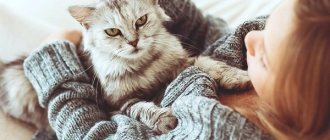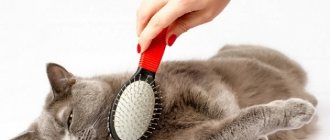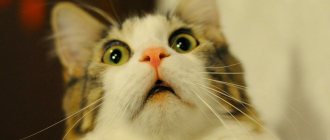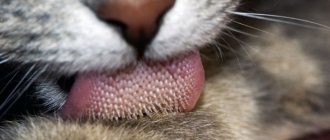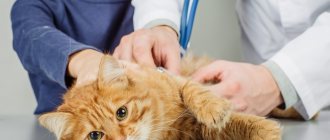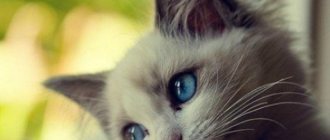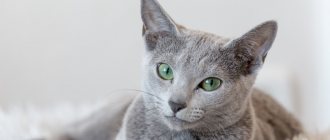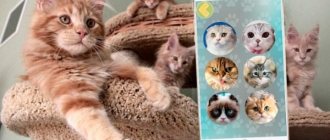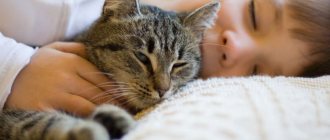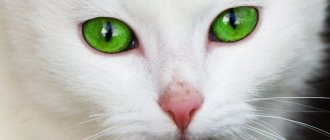A cat is a social animal; the animal is able to tell its owner about its problems using facial expressions, gestures, sounds and smells. The smell of pheromones secreted by a pet is not very clear to humans, while screams, purrs or meows can be easily deciphered.
Carrying out many years of research, felinologists were able to compile a “translator from cat to Russian.” Having carefully studied the “translator”, a person can easily understand the desires and mood of a pet, which will greatly simplify coexistence.
In the age of universal computerization, to study the “cat language” it is not at all necessary to read the works of scientists; it is enough to install a special program on your smartphone or tablet to understand the furry animal. The application, analyzing the animal's voice, will make a fairly accurate translation of cat cries, meows, and purrs into human language.
Voice signals
Most often, cats convey information using their voice. This is how they protest, threaten, beg for a treat, or attract attention. For each situation, the cat has a corresponding set of sounds. The vocal abilities of cats are very impressive. In terms of pitch, the animal can produce sounds in the range from 75 to 1520 Hz. Fear and aggression sound “low,” while higher sounds are used to express pleasure and tenderness. The mother cat generally communicates with kittens in the ultrasonic range, which the human ear cannot perceive.
There are at least sixteen different sounds used by cats. Moreover, the “talkativeness” of a cat may depend on the breed. For example, Siamese and Oriental cats “communicate” most often. Purring and rumbling are generally characteristic only of small cats; their larger counterparts practically do not use such sounds.
The purr of a cat is a symbol of sympathy and good-natured disposition. Purring, the cat calls the kittens. Rumbling, on the contrary, warns kittens about danger, and the cat also communicates its aggressiveness and readiness to get into a fight.
Oddly enough, hissing is not a sound of aggression, but rather a symbol of fear and the inability to escape. If snorting and hissing are accompanied by forward movement of the body, this is a signal for a fight. But more often, snorting indicates doubt: fight or run?
Cats rarely resort to a signal such as teeth chattering. Basically, this is a reflex when seeing prey that is out of reach of the animal. The cat chatters her teeth when she teaches her kittens to hunt, literally “I see prey!”
A cat's meow is a conversation. Vowel sounds express a request, complaint or bewilderment, for example, “let me out”, “I’m hungry”, “I’m bored”, “help”. Each cat is individual in the manner of meowing.
Newborn kittens acquire their “vocal” abilities gradually, learning from adult animals. As a rule, a kitten can produce a full range of sounds by the age of three months. Further, the palette of sounds can be enriched under the influence of personal experience, training and the external environment.
How cats take revenge on humans
According to experts, cat revenge is a myth. Negative memory in these animals is very short-term. In fact, the pet’s “dirty” behavior has a completely different explanation.
“Let’s say the owner yelled at the cat, and she peed in his shoe. The person thinks it is out of revenge. However, in this way the cat wants to mix its smell with the smell of the owner in order to be closer to him. And it’s possible, if a cat is a leader by nature, then show in this way that she is the “master” of the house,” Mayorova explained.
Undesirable deviations in the behavior of domestic cats can also be associated with sexual behavior (marking the territory in order to attract individuals of the opposite sex or confirm their dominant status), processes of ranking by status, especially if there are several animals at home (fighting, marking on favorite places, gnawing, marks on objects with the help of claws), lack of a sense of security (a cat can mark its own bedding or the owner’s favorite things on which it can sleep - its own smell in this case calms it down).
March 1 is International Cat Day. This is an unofficial holiday, like several others that are proclaimed in different countries. But everywhere, Cat Day serves to glorify their merits and express gratitude. It has become a tradition in many cultures to hold thematic festivals, mass celebrations, competitions, competitions, exhibitions and fairs.
Cat facial expressions
Cats also transmit many signals through their facial expressions. Unlike the sound scale, facial expressions and gestures are innate. Newborn kittens already “know” the meaning of facial expressions and gestures at the level of instincts and use them adequately.
Cat facial expressions are very expressive and varied, thanks to the extraordinary mobility of the facial muscles of the face and head. And cat's eyes very clearly reflect the mood of the animal. For example, half-closed eyes indicate peace and relaxation, while wide open eyes indicate interest or concern. Dilated pupils - fear, squinted eyes and staring - a challenge. A cat's gaze averted to the side signifies submission. If the pupils sharply constrict and the cat is concentrated on one object, it is ready for aggression.
A cat's ears can also tell a lot. If the ears are facing forward, the cat is relaxed, interested, or greeting someone. Ears pressed to the sides of the head indicate pronounced aggression; ears pulled back and pressed to the head indicate fear and confusion. Nervous twitching of the ears means that the cat is irritated or unsure of itself.
Cats can move their eyebrows and whiskers and use this facial expression to communicate. If the whiskers point forward, the cat is interested, excited, or ready to act. The mustache is spread out on the sides of the head - calmness. Hairs are collected in bunches and pressed to the cheeks - fear or anxiety.
A contented, calm cat keeps its mouth closed or slightly open. By the way, the protruding tip of a relaxed tongue is a sign of supreme bliss and complacent disposition. The mouth is open, the lips are raised in a grin - the cat is about to attack. A “grin” in a cat, oddly enough, means that the animal is studying the smells that interest it, especially those of other individuals of the opposite sex. A long full-mouth yawn means complete relaxation, but a quick licking of the lips, on the contrary, is a symbol of anxiety or confusion.
If a cat rubs its head or its whole body against you, or, as they say, gets under your feet, it is showing a feeling of sympathy. Sometimes this may mean asking for something. For example, about reciprocal affection. Is your cat rubbing its forehead against you? This is an element of intimate affection, a symbol of the highest affection for the owner.
Paws and the position of claws also mean a lot in a cat's language. In a moment of irritation or anxiety, a cat may strike sharply with its front paw. The claws are not released; this strike is preemptive in nature. A soft touch with claws drawn indicates affection. Handling the front paws, coupled with purring, is an expression of satisfaction. This gesture is preserved in adult animals from a very early age, when in this way the kitten massages the mother's nipple while eating.
Communication with a cat - body language and postures
Cats by nature cannot speak. Body language and facial expressions are the only way to express your emotions. To understand what your pet wants to tell you, you need to learn to understand its actions and gestures. There can be quite a lot of them. They use their paws, tail, ears, eyes and even whiskers to communicate. Sign language is divided into groups:
- Gestures directed towards the owner (hisses, licks hands, etc.);
- Gestures addressed by animals to themselves.
How to understand the “language” of cats? It's not difficult at all, the most important thing is to watch them a little. One of the main groups of gestures is licking. It not only means that the cat is washing itself, but also that it wants to tell you something. For example:
- the cat licks itself with sharp, drawn-out movements, he wants to say that he is yearning and requires attention and affection;
- After a cat has been scolded for an offense, it begins to lick itself sharply, thereby expressing confusion. This period is considered the best for reconciliation with an animal;
- the cat licks the owner’s hands, stretches out its paw to your face, thereby expressing a good mood and love for him;
- the cat climbs onto its knees and licks its hands - looking for warmth and affection.
- He stares at you, and when you pay attention to him, he runs away shouting “Purrrrr” - a challenge to a game of tag.
- Mustaches down - concern, sadness or illness.
- He hides his head in some corner - in the game - “mind me, I’m hiding.”
- Looks around intently and then carefully licks its fur - complete or feigned calm.
- He quickly licks his front paw - he is worried, indecisive.
- He quickly licks his nose and lips, confused.
- Stroke a person with his paw - close affection, tenderness.
- Scratching loudly with its claws - a desire to attract attention.
- Arches his back - intimidation of the enemy, very strong irritation and readiness for defense.
- He runs away from you, pulling his head into his shoulders, on long legs - he knows that he has done something wrong.
- The cat rolls around on the floor - demonstrates its attractiveness.
- He lies on his back with a thoughtful look - he is ventilating, resting.
- He sits with his paws tucked in, his tail turned around - watching, relaxed, waiting.
- He dances, lifting his front paws off the ground and putting them back - a greeting to someone loved and long-awaited.
- It turns its back to the owner and raises its tail - a sign of trust and respect.
- Trampling with its paws - it loves you very much, it wants to please you.
- Rubbing your head against a person is love, devotion, sincerity, a thirst for affection, and also a sign of estrus.
- He sits with his paws tucked in, his tail turned around - watching, relaxed, waiting.
Movement of the tail and body is also the sign language of the animal. Expressing love and gratitude, the cat rubs its muzzle against your face and legs. The tail is an “indicator” of a cat’s mood:
- tail “pipe” - means joy, inspiration, greeting;
- lowered slightly down - this is how the cat tries to express its dissatisfaction or fear, in this case it is better to leave it alone;
- dropped low - your pet is unhappy, scared or offended;
- the tail is loose - the cat is preparing to attack;
- twitches rhythmically - the cat is angry, irritated.
- A tail frozen at the bottom is disgust, disappointment.
- Moves the tip of the tail - interest.
- The tail raised vertically has a relaxed tip - joyful excitement.
- Beats its tail - it is angry or hunting.
By observing your pet, you can recognize many emotions expressed by it. Half-closed or squinted eyes indicate complete self-confidence. A raised head and a straight back indicate that the animal is relaxed.
A cat's eyes are a mirror of emotions. Attention expresses a direct and open gaze. At the same time, a frank look into your eyes means a challenge or a requirement to keep your distance. If a cat has dilated pupils and a “crazy” look, the animal is scared and cannot control itself. A hug with paws is the strongest demonstration of love and devotion to the owner. Also, when a cat, lying on its back, exposes its stomach to you, it expresses love and trust. At such a moment, you definitely need to stroke and caress her - the cat will be devoted and grateful to you!
- Large eyes and pupils - peers into the darkness, is afraid, angry or plays.
- A third eyelid appears - the cat is sick or wants to sleep.
- Squinting eyes - calmness or drowsiness.
- Squinting his eyes - peace and tranquility.
- Ears flat to the sides - hiding, flirting
- Wide-open pupils - fear.
- Ears set vertically - curiosity.
- Ears flat to the sides - hiding, flirting.
- Ears back, eyes squinting - impatience, a request.
- Ears tilted back, eyes large - a warning.
- Ears pressed to the head - preparation for an attack.
- Ears pressed to the head, tail making circles - irritation
Body movements
The most visible part of a cat's body is its tail. It is he who expresses the cat's feelings and emotions most clearly. Only by the tail can one judge the cat’s states and intentions. The tail is raised up - your pet is in a good mood, friendly and ready to communicate. Kittens' puffy tails are a symbol of their interest in the world around them. A raised tail is a call to play.
If the tail, on the contrary, is lowered and tousled, this means that the animal is alert. But if the fur is raised only at the base of the tail, the cat already knows what to do in this situation. Severe fear is expressed by the tail tucked between the paws.
An aggressive animal can be recognized by a highly raised, tense, tousled tail in a dominant animal and a lowered, arched tail in subordinates. A horizontally extended tail twitching rhythmically is a sign of irritation, but if the tail is knocking on the floor, the cat is more likely to be scared. If the amplitude of movements increases, and the animal literally whips itself on the sides with its tail, this is pronounced aggression.
Depending on how fast and what part of the tail the animal moves, emotions are determined. For example, a slight waving of the tip of the tail indicates relaxation; at first, a slow, and then increasingly rapid swing of the tail occurs before jumping on the object of the hunt.
The cat's pose expresses its own state, and also depends on who it is addressed to. The pose when seeing a strong opponent is different from the pose with which a cat meets an aggressive fellow tribesman. The threat pose allows the cat to look larger and more impressive: the legs are extended, the animal stands on tiptoes, the back is arched, the tail is curved, the hair stands on end. In an excited or frightened cat, the cheek nodules move, the hair on the cheeks bristles. The threatening pose is complemented by ears pressed to the back of the head, the nose is wrinkled, the fangs are exposed, and the corners of the mouth are drawn back. The cat purrs and hisses.
Cats sense the threat distance well: the distance from the enemy to the cat that no longer feels safe. Usually the animal prefers to flee, although it takes a threatening pose. But if the cat is cornered and cannot escape, and the threatening pose has no effect and the enemy continues to approach, the cat rushes to attack. This distance is called the “distance of aggression.” But for a mother cat there is no difference between “threat distance” and “aggression distance”; she will not run, but sees the enemy from afar. The cat rushes towards the enemy, jumps on all four legs, straight and outstretched, while remaining turned sideways to the enemy, the tail is raised high and fluffed. Such a cat is ready to fight to the death to protect its offspring.
In relationships with aggressive fellow cats, cats use other postures. The animal practically does not hunch its back and does not bristle its fur, but only slightly fluffs it on the withers and tail. Distance is not particularly important; the animals stand nose to nose, looking into each other's eyes, howling and purring. Cats try to remain motionless in order to suppress the enemy's morale, but the blows of the tail on the sides mean that the animal is ready to rush into a fight at any second.
When the fight begins, the first blow with the paw lands on the opponent's nose. The attacker then tries to bite the back of the opponent's head, and if this succeeds, the opponent falls on his side. A cat that does not want to engage in a fight takes a pose that combines elements of submissiveness and threat: the animal presses into the floor, lies on its side or back, putting its paws forward with its claws extended. The winner of the fight is eliminated first, trying to retain as much dignity as possible.
When communicating with people, cats rarely carry out their threats. Animals have developed inhibitions that inhibit aggression towards the owner. But if the animal is threatened by a stranger, the cat will aggressively defend itself and can seriously injure the person.
The most graceful demonstration of contentment and complacency is when a relaxed animal lies down, showing an unprotected belly. The paws are spread out to the sides, the claws are hidden, the pads can be compressed and unclenched. The eyes are half-closed, the pupils are constricted. This pose demonstrates complete trust, since the stomach is the most vulnerable place on the body.
Cats show indecision in a very interesting way. This condition is always accompanied by licking of fur. The more decisively the cat licks itself, the more serious the problem it solves at that moment. Licking calms the animal, neutralizes irritability and possible aggression. Cats often lick their cubs, other animals and even their owners, showing their affection and calling for calm.
The emotions of the owners are transferred to the animals. Nervousness, tension, the appearance of a small child who makes the cat jealous can lead to pathological behavior of the animal, expressed in the fact that the cat licks itself until certain parts of the body are completely bald.
Head, paws, torso
To convey important information to others, cats use literally everything!
No part of the body is left “overboard”. Take, for example, the head. If a cat butts it, poking at a person’s legs, it means it attracts attention. In the same case, when two animals touch their foreheads, you can be one hundred percent sure that there is friendship and complete mutual understanding between them
shutterstock
If a cat moves its paws as if trampling, it means that it is happy with everything and is absolutely happy. This gesture is born in childhood. Kittens, sipping mother's milk, seem to massage her belly with their paws. In their language it means boundless love, gratitude and bliss.
Step-by-step instruction
The most famous talking cat in the world is the Azerbaijani Masi. He is able to pronounce several dozen words both in Russian and in his “native” language. The pet's vocabulary includes such etiquette expressions as “thank you” and “goodbye.”
Table 4. Teaching a cat to talk
Stage Description Step 1 Decide on your pet’s favorite treat and make sure it is on sale. It is advisable to assign a specific food stimulant to each word. You should not give your pet food that may cause stomach upset or obesity. Step 2 To get in tune with your cat, you need to spend some time together
Pets are very easily distracted, so it is necessary to gain the animal's attention. Step 3 To arouse the cat's interest, you should kneel, but at the same time remain above the level of the animal's head. Otherwise, the pet will consider itself to be in charge. Step 4 Sitting on your lap, start meowing.
Continue this process until the cat begins to meow in response. After this, you need to treat her with a treat and pet her. Step 5 Take a 15-minute break, giving the animal the opportunity to rest. During the time-out, joint games are allowed. Step 6 Repeat steps 3, 4 and 5. Step 7 Start saying the chosen word to the animal until it meows in response. After some time, the cat may give out the long-awaited “meat” or “eat.”
Meowing with a cat should be gradually replaced by pronouncing the necessary word
Before you start training, you need to arm yourself with patience and be confident that the pet living next to you is unique. Without these components it is impossible to achieve success in such a complex process.
Annoyed
Cats that are mildly stressed or trying to avoid something unpleasant for them squint, blink rapidly and/or look away. The body will be tense and possibly pressed to the floor. One paw can be raised slightly upward to cover its muzzle if necessary.
At the same time, you may notice that the cat yawns, licks the area around the mouth, often drinks water, and blinks. At the same time, the pupils may be dilated, ears perked up in different directions, and mustaches sticking out forward. The tail is either held tightly to the body or twitches and sways from side to side. All these methods help to strengthen environmental monitoring.
Professional opinion
A protruding tongue may indicate a relaxed cat.
No matter how touching an animal that shows its tongue may look, you should never forget about the danger. Scientists have repeatedly stated that today we strive to first capture everything unusual or funny that we see, and only then we begin to think about what it could mean.
- First of all, a protruding tongue in a relaxed state means complete peace.
- Secondly, this may indicate problems with heat exchange, and here it is necessary not to film what is happening on camera, but to take care of saving the pet from the heat.
- Thirdly, and this is perhaps the most significant, any changes in the animal’s behavior, along with the unexpectedly emerging habit of sticking out its tongue, can indicate dangerous and contagious diseases. For example, an acute viral infection - rabies - is characterized precisely by the fact that the cat’s behavior becomes aggressive, it can run with its tongue hanging out like a dog, and there is profuse salivation. At this time, the animal poses a threat to everyone, because they have not learned how to treat this disease.
Californian researchers believe that in adulthood, a cat's tongue may not fit in its mouth due to diseases of the teeth, gums and oral cavity.
Veterinarians also agree that when you see a protruding tongue, you should not be moved and tell everyone what an interesting cat lives in the house, but first show it to specialists in order to rule out a number of diseases dangerous to the animal and people. The inspection will take a few minutes, and then, if everything is in order, you can continue to be touched.
